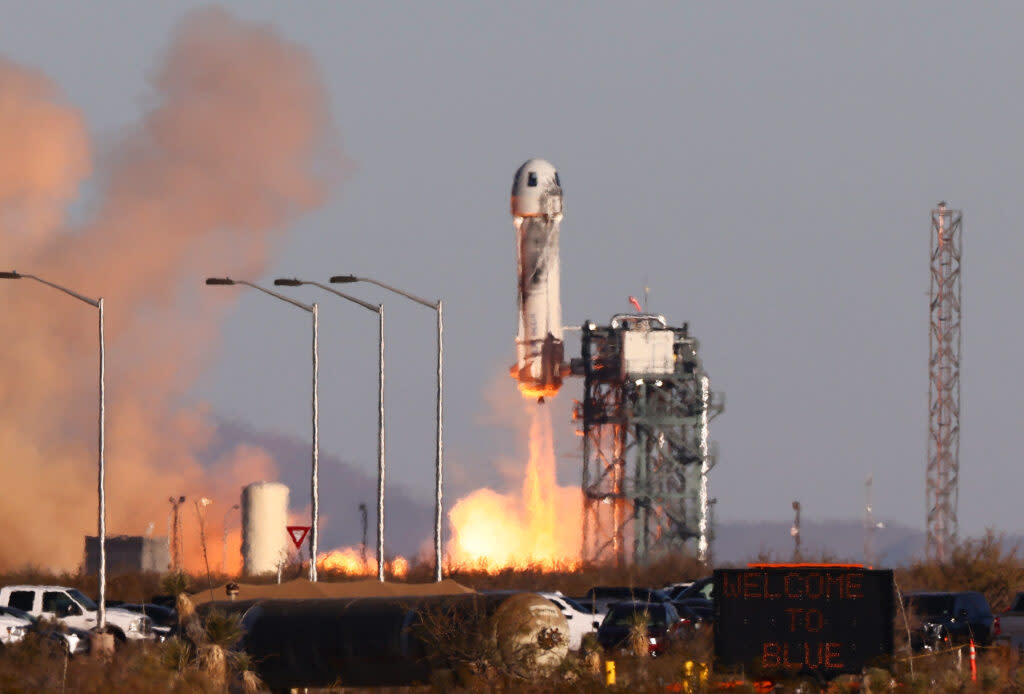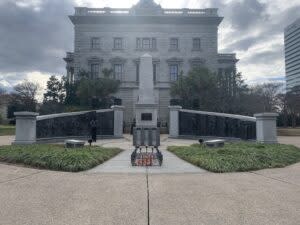Sculptor of monument on SC Statehouse grounds reflects on his view from space

- Oops!Something went wrong.Please try again later.
- Oops!Something went wrong.Please try again later.
Blue Origin’s New Shepard lifts off from the Launch Site One launch pad carrying Good Morning America co-anchor Michael Strahan, Laura Shepard Churchley, daughter of astronaut Alan Shepard, and four other civilians on December 11, 2021 near Van Horn, Texas. The six are riding aboard mission NS-19, the third human spaceflight for the company which is owned by Amazon founder Jeff Bezos. (File/Mario Tama/Getty Images)
Ed Dwight, one of six passengers on Blue Origins’ seventh manned flight into space, feared for a moment something had gone awry.
As the rocket launched last month, the light below him was so bright, he thought it had exploded. The noise of the engine was deafening, even through his earplugs.
“Ah, well,” was his first thought, he told the SC Daily Gazette this week. “I had a nice life.”
But the rocket didn’t explode. And Dwight went roaring into space, soaring through the atmosphere and, at 90 years old, breaking the record for the oldest astronaut in space for his 11-minute trip.

Dwight, who is based in Colorado, is best known in South Carolina for his sculptures, which include the African American History Monument on the Statehouse grounds and, more recently, a statue of Harriet Tubman at Tabernacle Baptist Church in Beaufort.
But before becoming an artist — or a restauranteur or construction company owner, his other previous professions — he trained to become the first Black astronaut.
“Ed Dwight, not only do you capture history with your hands, but you make history,” reads a Facebook post from the group behind the Harriet Tubman monument. “You are history.”
The first Black astronaut candidate
As Dwight tells it, President John F. Kennedy selected him to bring some diversity to the space mission, then in its infancy.
But after Kennedy’s assassination in 1963, Dwight lost his chief sponsor, and NASA passed him over when selecting its next cohort of astronauts.
“A lot of people didn’t want any Blacks or women in the space program, because it was all about heroes — Superman and Daredevil and all that stuff,” Dwight said. “Of course, white men considered themselves the Superman, and they didn’t like the idea of having super women or super Black people.”

Dwight left the Air Force a few years later. The first Black astronaut would not leave Earth’s atmosphere for another 20 years, when Philadelphia native Guion Bluford went up in 1983.
Over 60 years later, Dwight doesn’t harbor any resentment.
He decided to take the May 19 trip into space for all the people in his life who were angry on his behalf at losing that chance when he was younger, not for his own sake, he said.
Dwight is happy with the way his life turned out, “making huge memorials for people to visit that are going to be there for the end of time,” as he put it.
Finally taking the trip he didn’t get 60 years ago showed that hard work does pay off, even if it takes decades to show it, said Rev. Kenneth Hodges, pastor of the church that commissioned the Harriet Tubman sculpture.
A lot of people who have visited the monument, which was unveiled earlier this month, have heard about the oldest man to go into space but don’t realize he’s also the artist behind the piece, Hodges said.
“It shows the determination of a person and lets us all know you can still accomplish your dream — it doesn’t matter how long it takes, it doesn’t matter your age,” said Hodges, a former state legislator.
And an offer to go into space is tough to turn down, he added.
Space for Humanity, with support from the Jaison and Jamie Robinson Family Foundation, sponsored Dwight’s seat on the private flight, according to Blue Origin. The company, owned by billionaire Jeff Bezos, has not publicly disclosed the price of the tickets.
The view from space
Dwight logged so many flying hours in his youth, he was prepared for the force caused by the rocket’s acceleration, known as G force, which can cause some people to pass out. What he wasn’t prepared for was the view, he said.
He had thought the dividing line between the Earth’s atmosphere and the space beyond would be a more gradual transition, but instead he found it to be one sharp, distinct line.
At first, everything went blue-black. Then, the ship rocketed into space, and Dwight got a glimpse of the Earth, appearing to sit all on its lonesome against never-ending darkness.
As the five other passengers screamed and clapped and kicked, Dwight looked out at the Earth growing smaller beneath him and thought: “I get it. I get it. Now I get it,” he said.
He likened the experience to looking down at a playground from the top of a slide.
“You see all these people, and they have the ability to play and to drive and to ride their bikes and do whatever they do,” he said. “It’s just the damndest thing. The feelings you get are really incredible.”
Along with those feelings came a philosophical question Dwight has been chasing in his artwork for years: Why can’t those people just get along?
“When you get above it all, you don’t see any dividing lines between the states or dividing lines between the countries,” Dwight said. “It’s just amazing thinking, ‘Everybody down there should be really getting along with each other, because this is just one place that we’re all in.’”
That’s not a new question for Dwight, but a reminder of one he’s had for a long time, he said.
In his artwork, such as the monument beside the Statehouse that traces African American history in South Carolina from the slave trade through the 20th century, he tries to teach people about the past in a way that will help them lead better futures, he said.
“What we’re really trying to do as artists and peacemakers is we try to make life a little bit more livable, to have something that people can enjoy,” he said.
The post Sculptor of monument on SC Statehouse grounds reflects on his view from space appeared first on SC Daily Gazette.

